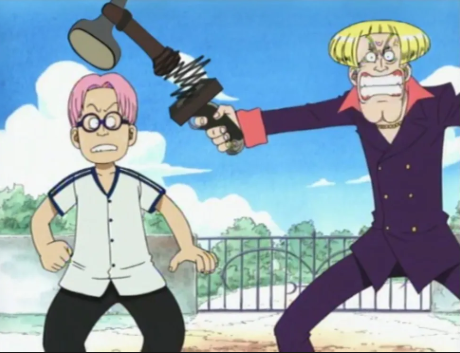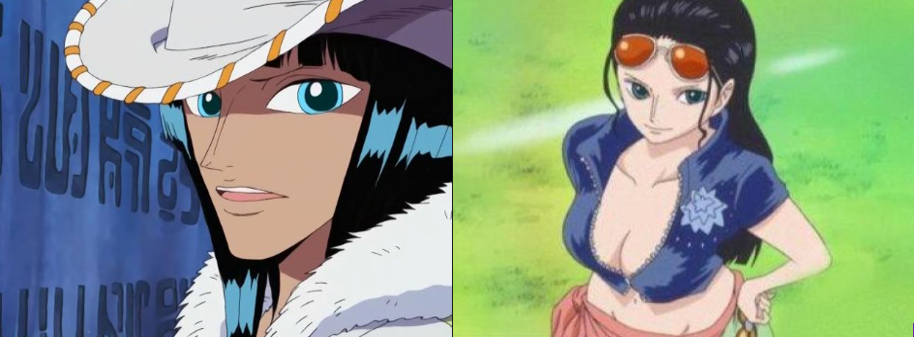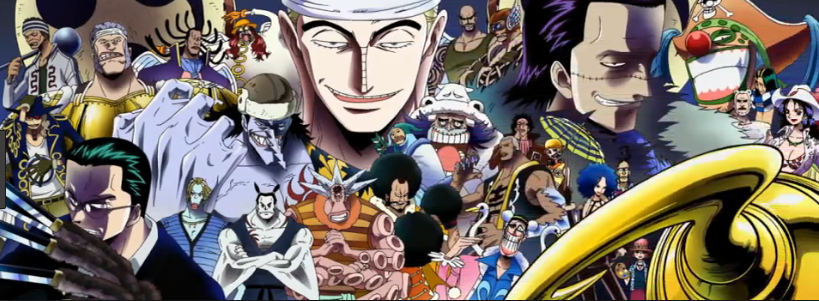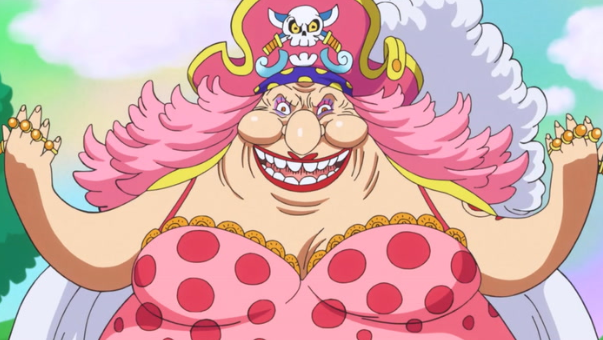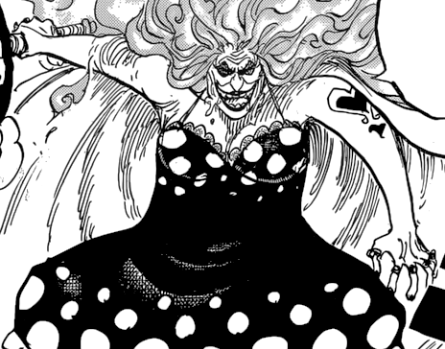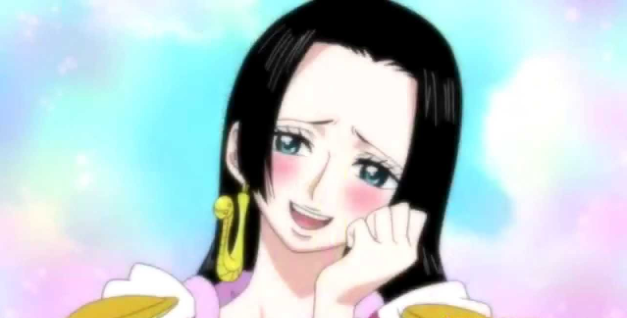Thoughts on ... Eiichiro Oda & "Bad" Women
A long time ago, whilst searching for a new anime fix following the ending of Shaman King on Jetix, I stumbled across the cringiest rap ever on a newer channel, Toonami. Some strange child danced across the screen, apparently made of rubber, and a bunch of white men sang “ga-go, ga-go!” It was an experience for sure, and in my shock, I tuned in, wondering if I would ever find a reason behind the madness. What followed were several weeks of extravagant pirates wielding apparently lethal hammer-axe contraptions, unpronounceable names, and copious lolly-pop sucking. A bewildering viewing experience became mild curiosity, and then somehow, I grew to love it. The art was crazy and the voices grated on my skin, but even so, the story excited me enough that I returned to it every day after school. That One Piece withstood 4Kids’ butchery is testament to its phenomenal source material. My experience with it is no different from most Western fans’: somehow, something made us look past the massacre that was the 4Kids dub to continue following Luffy, Zoro (Zolo, just like a samurai), the unshy Nami, Sanji, Ussop doing his marksman thing, and Chopper “doctoring” in the background.
lol
Through discovering the animanga community online, I got to read One Piece from the beginning, and watch the original Japanese version of the anime, and I grew obsessed. What starts out as a small, unplanned voyage by a childish rubberman becomes an epic tale of government corruption, slavery and abuse, childhood trauma, death and bravery, discrimination and racism against minorities, conspiracies, and massive mysteries that pervade the course of over 900 chapters. That One Piece has entranced an audience for now over 2 decades, and has virtually been the road map of a generation’s formative years akin to how so many of us literally grew up with Harry Potter, is impressive as it is admirable. I think what Eiichiro Oda’s done with his story is brilliant, and I’ll always be a fan of the series, despite my disappointment at the ambling plot of Fishman Island (saved only by Shirahoshi’s secret), and the overly-long Dressrosa, and the indulgent interruptions that ruined Luffy’s fight with Katakuri on Whole Cake Island (which I felt could have been the post-timeskip version of Luffy vs Rob Lucci, but the random cutoffs to Sanji putting icing on a cake, and Smoothie looking for something to do, when I really just wanted to see the fight in its entirety, really ruined it for me).
I’ve always enjoyed reading the SBS segments in the volumes. They carry a wackiness that is rare in comparison to the stiff-upper-lip culture that I’m used to, and foreign to me is the concept of a world-renowned author having fun with his audience. Oda clearly doesn’t take himself too seriously, which is a stark contrast from many of his western counterparts. However, in recent months, the SBSs have taken on a strange tone, like below:
Taken from the One Piece wiki
[Additionally, Oda has mentioned in the past that he has had female complaints before, but as his audience is for male readers, he chooses to cater to them instead. Over the years his comments on this issue have become increasingly careless]
The audience that once giggled childishly to Oda’s portrayal of women has matured. Oda’s dismissive comment about female complaints implies that he’s aware of the impact the story has on female readers, and quite simply doesn’t care.
Obviously, as I writer I understand the importance of telling the story that you want to tell, in the way that you’ve always envisioned—after all, one of the most common bits of advice most aspiring writers receive is “tell the story you want to read”. I don’t think there’s anything particularly wrong with that sentiment, and I find that our anxiety to not offend others stops us from creating stories with nuance and sensitivity. We avoid self-education to avoid outrage. On the other hand, if there are valid criticisms of an author’s influence on society, and the responsibility of said author to be mindful of harmful stereotypes that they exploit in their work, I think they should be graceful enough to at least acknowledge them.
#MakeRobinGreatAgain
Recently, a white author (who will remain unnamed) faced backlash after her supposedly progressive anti-Islamophobia novel fell into outdated and quite embarrassing depictions of Muslims. Whilst she meant well, she ended up going the way of Joseph Conrad instead of N.K. Jemisin, if you know what I mean, and a previously favourable review of it was removed from Kirkus. A period of reflection to listen to the community she was apparently trying to help would have really shown whether she truly cared for and respected her readers, or if she had been trying to make money from the Woke Industry at the expense of a highly persecuted minority group. This author’s many Facebook rants and tirades on Free Speech indicate that she fell into the latter, and I feel that Oda, whilst clearly not trying to appeal to modern consciousness, has ridden the acclaim from his sensitive writing on some social justice issues (like racism and slavery, the class system and religion), whilst abandoning his decency for others.
The subject of women in One Piece is not new to the community. I guess, because I was much younger than I am now, I barely noticed the issues of sexism in the story when I first read it. It took a thread on the Arlong Park forums, solely dedicated to the subject (which if memory serves, went on for well over 30 pages), to make me realise that there are some serious issues with the story in this regard. The topic is now pretty well-worn, and all angles have been examined by fans and non-fans alike, but after briefly discussing a certain character with a friend on Twitter a few months ago, I realised that I have a major problem with how Oda portrays female beauty, and how he juxtaposes it with villainous women in particular.
D’you remember when Buggy had that glow-up in Impel Down?
In One Piece, villainy is ambiguous; you can be part of the military, the government, a religious sect, the aristocracy, piracy, or a random, disenfranchised motley crew. Women pepper these various social groups. They are few in number, and perhaps the only time women greatly outnumbered the men was during the Amazon Lily arc—but we’ll get onto that later. To avoid pointless whataboutery, I won’t go through every single woman in the story, but the ones who obviously have a major impact on it.
There are plenty of ugly male villains: Charloss, Blackbeard and Helmeppo are good examples of this, and still, Oda has a habit of making powerful female villains particularly unattractive, juxtaposing them with his unrealistically drawn male fantasy-type women on the good side. Interestingly, when we do come across conventionally pretty female villains, Oda just has to make them turn good again, or sympathetic in some way—it’s almost as if he cannot bear to think that a pretty woman can be evil.
What’s being said here is that female villainy and ugliness are synonymous, and only pretty women have a chance at redemption. This is only really something that we’ve seen done so haphazardly with the women in the story: male characters, whether good or bad, occupy various positions on the ugly/handsome spectrum, and they change allegiances regardless of their looks (Bon Clay, Katakuri, Jimbei, Law. Their looks are all irrelevant because their character arcs are all so diverse and complex). Oda is particularly bad with older women: why are Kokoro and Shinobu, two formidable women who are integral to their respective allies’ plans (in Water 7 and Wano respectively), subjected to gag jokes about their appearances? What explanation is there for Mother Carmel’s rough transformation from the blonde beauty of her younger days? Older men are not treated so disrespectfully by other characters in quite the same way.
‘nowt wrong with liking a treat
Alvida and Big Mom are textbook examples of “ugly” villains: both powerful, only two of three female captains in the series, and are both defined by their obesity. Of course gags ensue because fat is ugly, I guess? And interestingly, both of these women undergo the ol’ favourite sudden drastic weight loss when they reach their peak power. I’ve always cringed at this trope whenever I see it in manga, as it just seems so overdone now. I remember my disappointment when Hikifune from Bleach suddenly shed her weight after being introduced as a plump, stout character. I was excited to see a female character who didn’t fit the typical Bleach aesthetic, and who was one of the most powerful characters to boot. Interestingly, Hachi, an overweight male character from the same series, never has a weight loss transformation. In contrast, Biscuit’s Hunter x Hunter muscle-mammoth power up is a refreshing change.
To be fair to both Alvida and Big Mom, they are as equally recognisable by their status, abilities and quirky characters as their weight, but I thought they were both notable in that they both undergo more cishet male-pleasing designs when their powers improve. I always take an issue with overweight villains because the weight becomes a part of their villainy, and it opens the door to cheap fat jokes on the hero’s part, when I think we should be trying to de-normalize fat insults in general. As villains, Oda chose to combine their weight with their villainy, which brings a host of implications.
wait… who’s that?
As expressed before, we have the villain-turned-good girls, one of Oda’s favourite devices. These are pretty women who just so happened to be swept up in bad behaviour, and all they needed was a valiant man to make them turn from their wicked ways. One of manga’s biggest abusers of this trope is Hiro Mashima of Fairy Tail fame. Almost all of his female villains had some tragic past that forced them into destruction, and just a small sweet word from one of the Fairy Tail mages turned them to the good side again, tears and all. Ultear, Flare, Minerva, Brandish, and so on, change their entire characters within a chapter, all because they witnessed “the power of friendship”, all past transgressions totally forgotten.
In One Piece, the transformations of such women are so sudden, so unrealistic, that even the other characters in the series are perplexed by their rapid turnaround. Baby 5 and Pudding’s character arcs were really quite shocking. They both occupied important positions on two of the worst pirate crews to date, enjoying special powers that were vital to their teams’ success. We see several flashbacks of Baby 5’s earlier life, revealing her steadfast loyalty to Doflamingo, despite the tensions stemming from his mistrust of her male suitors, leaving her lonely and yearning for companionship. Despite her somewhat restricted romantic life, we are not given any indications that Baby 5 is deeply unhappy to be part of Doflamingo’s family, in fact, her partnership with Buffalo works so well, and it’s clear she values her connections with everyone on the team. She is given a disabling character flaw (fatal naiveté) which then becomes a plot device for her to become enamoured with Sai, her enemy of just a few short panels before. Within one fight, Baby 5 is betrothed to a man she just met, and her ambitions are limited to being a wife—nothing more. Throw in some tears and a quickly tacked-on sob story and our cool, weapons-wielding fighter is a gushing bride, villain no more.
is this convincing in any way?
Pudding, too, is given similar treatment. We are shown her vindictiveness, and how cold she is towards Sanji. Her entire story arc is plagued with malice—something she inherited from her mother, to her own detriment. To be fair, there are times when we can see her discomfort towards Big Mom, but her ability to play the sweet Pudding-Chan and then assume the darkness of Charlotte Pudding is evidence that she made villainy her own, ever mindful that her third eye is a valuable and lucrative item, something she can use to her advantage. So colour me genuinely shocked when Pudding was reduced to a blubbery, heart-eyed mess after one small compliment from Sanji immediately before the execution of Big Mom’s grand plan. I’m assuming, being a Yonkou and all, Big Mom didn’t just dream up the big assassination plot on a whim during afternoon tea: she’s known for collecting names and taking souls. This could have been months or years in the planning, with Pudding knowing the role she was about to play, and being committed to it during all that time. She gets to the altar, brandishes the gun to kill Sanji, and just because he remarks that her eye is pretty, she drops the gun and stops the plan—we are then subjected to a random whistle-stop tour of Pudding’s eye insecurities, a backstory that had no prior foreshadowing. At best, it’s a poorly handled plot device, a means to quickly dissolve the assassination plot without really thinking of a complicated story, at worst, it’s a portrayal of another female villain as pathetic and easily distracted. Like Baby 5, Pudding’s heart sways her, enraptured by a male, and because of her erratic emotions, the plans all come to a halt. A flimsy betrayal.
I’m particularly salty about Hancock. One of the most powerful people in the One Piece world, leading an all-female army on an all-female island, occupied with women of various shapes, sizes and temperaments. Amazon Lily is a haven for Hancock and her sisters, who suffered slavery and sexual exploitation at the hands of noble men. Their pirate crew stands as a defiant protest against the sleazy, male-dominated seas, and Hancock is a great leader, albeit narcissistic, cold and ruthless. Her cruelty isn’t understandable to the reader initially, but once her history of abuse is revealed, it leaves a lot of room for empathy and understanding. Her character is complex, still trying to make sense of years of torture at the hands of nobility, and navigating a world so dominated by men, and yet still having to assert herself within it, showing herself as a valuable asset to the military to grant her Shichibukai status, all for the benefit of her island. It’s both saddening and altruistic, and her beauty and strong devil fruit ability are bonuses.
the disrespect.
But Oda doesn’t leave it there. She goes the way of the others, swooning and crying and dreaming up childish scenes of romantic weddings and holidays after a short encounter with Luffy. She barely knows him, but his aloof manner and innocent demeanour turns her heart of stone into a sopping sponge. She’s totally in love with him, so in love that it incapacitates her, leading to a fever and sickness. Now we must endure Hancock the blushing child, Hancock with the high, squeaky voice, Hancock fainting, Hancock providing a banquet for her love, Hancock putting her life in danger to protect him in view of government officials, forgoing her sacrifices to risk her island’s safety.
What is concerning about all three women is the rapidity in which their emotions change. These are examples of unhealthy relationships: you cannot fall in love, to the point of fainting and tears and nuptials, in such short a space of time, and yet these powerful women totally transform within a page. The only male character who is close to matching these erratic displays of emotion is Sanji, and even his moments are played off as silly and comedic. He’s never really portrayed as fully, monogamously, loving these women: they are just pretty; embodiments of his personal fantasies. He doesn’t risk the safety of the crew, or prepare to destroy the plans of his friends, because he loved a woman. But these pretty pirate women are forbidden from being truly, 100% evil: all they need is male affection—to be “melted”, and their villainy is cured.
what is her purpose?
I think Reiju is worth mentioning briefly because she comes from a villainous family with a truly evil father and brothers, and as the only living female in their crew, she miraculously is unaffected by their influence. It is never explained why she wasn’t part of her father’s experiment, nor are we really shown her acting as evil as her brothers (after all, her father hasn’t been enhanced and is just as evil as them). She is simply there, totally passive, never telling them off, or giving her father a piece of her mind. She sympathises with Sanji and admits to hating the family to the point of being prepared to die with them, but she never leaves the Vinsmokes, enacting her father’s will on countless victims anyway. Her character is strange and inconsistent, and it’s almost as if she isn’t sure whether she wants to be a villain or a hero herself. Her exclusion from the Vinsmoke experiment seems to be a cop-out to avoid her being truly evil like the rest of her family, and it sucks.
Bad-woman-turned-lovesick-puppy is annoying enough, but equally awful is Bad Woman as Fanservice. Once again I think Hiro Mashima is king in this regard, although Kubo has a habit of putting his villainous women in uncomfortably compromising positions when fighting—especially when they fight men. Oda’s use of sexualising bad women is lazy as it is cringy, with Sadi-Chan being the most obvious. Of course she’s a sadist, wearing tight pink leather and donning whips, her face mostly obscured because it isn’t the focus in the first place: her body is, and it dominates her character totally. Of course she screams in pleasure whenever someone gets hurt—if she’s not going to turn into a good guy, may as well redeem her character in some way right? And I suppose for young men—Oda’s audience in his own words—villainous women are made palatable by their sex appeal. It feels good and yet oh-so-bad to like Sadi-Chan, and her fights are not to be taken seriously, they are just quirky encounters, a bit of fanservice to lighten an already intense arc.
I’m finishing this article at work. Do you know how stressful it is to search for Sadi-Chan in Google??
After Sanji bounces from his fight with Kalifa in Enies Lobby, we’re all treated to some girl on girl action when Nami takes his place. We don’t get to see Kalifa lathering Sanji’s body and making him moan and whine, just Nami, because that’s what Oda’s target audience likes—according to Oda. When the rest of CP9 get their devil fruit upgrades, we get the bizarre hilarity that Oda is known for, and what makes One Piece fights so unique and memorable: a giant giraffe and a wolf chasing a chained Zoro and Usopp combo, all the while a deranged reindeer stomps around wailing dumbly in the background, ready to kill them all. Kalifa’s upgrade was unique because it was the only non-zoan type, and it was the only one that could be used for some sense of visual titillation. Nami regularly gets paired with the female fighters, and it’s not the first time she battled against a visually appealing foe: Miss Doublefinger obviously shares a tailor with Sadi-Chan. I just think it’s interesting that the only female villain of the arc has a fight premised on fanservice, when we all know the hottest member of the team is Rob Lucci and we all would have felt better seeing more of him, but I digress.
I did say that I wanted to avoid whataboutery, but I would be dishonest if I ignored the characters who don’t fall into any of the categories I described above: their unattractiveness is not meant to denote villainy, and likewise is their attractiveness used against them to make their characters less impactful than when they were first introduced; they are not there for fanservice nor are they subjected to a myriad of cruel jokes.
In terms of villains, Perona is conventionally pretty, and Smoothie and Flambé of Big Mom’s crew fall into this category, but Dadan comes to mind straight away as a conventionally ugly woman who is not a villain. She almost risks her life when Ace refuses to back down from a fight, and provides Sabo with a refuge from the stifling ivory towers of aristocratic life. When any of the boys thank her, or say their farewells before leaving to be pirates, she does the stereotypically feminine thing and breaks down into tears, just what we would expect from the more damsel-type women in the series. When Ace dies, she is the only person with the courage to tell Garp the truth, using her emotions not erratically or to the detriment of those around her, but because she is truly and deeply sorrowful at the loss of her son, and the pain that Luffy suffered as a result. As a nit-pick, I would say that it’s interesting that she’s still a bandit living a life of exile, and not a normal functioning member of society, but I chalk that up to an endearing trait of her character. She’s a hoodlum with a good heart, much like the pirates that already dominate the story, and provides the “Night” to Makino’s “Day”. I like Dadan.
best girl dadan
So this was longer than I expected it to be, and to be honest I agonised during the writing of this thing. It took me perhaps three months of writing a paragraph here and there, and then leaving it for ages before picking it up again. This happened for several reasons, but one reason for sure was a fear of backlash. One Piece is popular, and critics of its female portrayals are met with true vitriol. I’ve seen friends online go through so much, from the spiteful to the downright threatening, their curiouscats and DMs littered with hate, all because they said “I think Oda’s sexist” or “Oda doesn’t know how to write female characters”. It’s bizarre as it is exhausting to witness, as I’m sure that many of the veteran readers of the series are at least 21, which is far too old to be acting so enraged because someone is critiquing your favourite literary work.
How we respond to manga-criticisms reveals how we really feel about the medium. Is it truly a literary artform, or is it just a bunch of drawings and cartoon characters? Because when people give harsh criticisms to traditional novels, they aren’t belittled in quite the same way. Manga is a legitimate literary medium, and its increasing popularity around the world means that it can culturally influence readers’ perceptions of real-life situations and social groups. Therefore, if a mangaka decides to add to negative portrayals, or lazy stereotypes, or harmful depictions of particular groups, then their work can stand for some commentary. In reality, these issues aren’t only harmful to women, but the takeaway here is that young men are raging hormonal idiots who simply want to see tits. We know this isn’t true: Hunter x Hunter, Shingeki no Kyojin, Vinland Saga and so many others are totally without fanservice, and young men love these series because the stories are well-written and the fights well-executed.
Only when we acknowledge the problems in the things we love, can we choose to counter and challenge the ways they might influence us. Refuse to see the problem, and you become a part of it.
